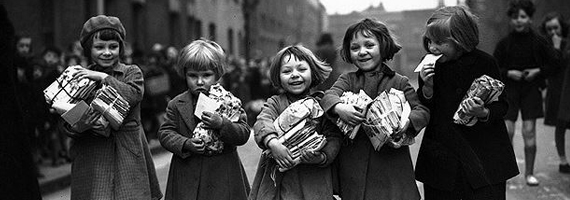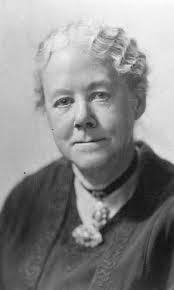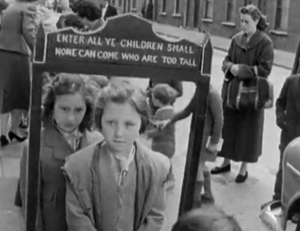
The young blond girl in the queue shifted around to see how near she was to the arch. There were only three more children to go. The lady at the head of the queue was handing out small bundles wrapped in newspaper to each child that passed under the wooden arch in exchange for a single coin. The girl glanced down to look at the farthing she held tightly in her hand and looked up at the arch again. It bore the legend “Enter All Ye Children Small, None Can Come Who Are Too Tall” and she stepped forward, her hair just brushing the underside of the archway. She handed her coin to the lady who accepted it with a smile and gave the girl a loosely wrapped parcel of her own.
This practice of handing out the ‘Farthing Bundles’ to children started in 1905, (although the little arch was introduced in 1913) by Clara Ellen Grant.

Clara Ellen Grant – The Bundle Lady of Bow
Born in 1867, Clara was one of nine children from a reasonably well to do family who grew up in Wiltshire village. She always wanted to teach, but initially, she began working with the Universities Mission in Central Africa. Following the death there of her fiancé, she returned to England, completed her teacher training at Salisbury Training College and moved to London. After a couple of teaching posts, Clara Grant became Head Teacher at the Devons Road Infant School on Bow Common, in the East End of London in 1900. The area already had a reputation for destitution, and Clara was shocked at the level of local poverty around her, particularly of the young children who attended the school.
As a highly motivated and determined Victorian Englishwoman, she felt duty bound to do something about the situation.
Clara set about looking at the whole structure of class room technique, eschewing the ‘children should be seen and not heard’ philosophy that had preceded her. She provided a hot breakfast for those children in her care – for many, the only hot meal of the day – and looked to her friends to help supply the infants with clothing and shoes. She even turned her home into a settlement house, which came to be known as the Fern Street Settlement, and which is still active to this day, providing pensioners with a day centre, a lunch club and a place for adult education classes. The Settlement also runs summer holiday camps for young people and gives out presents for children at Christmas.
But it is by her affectionately given nickname of the ‘Bundle Woman of Bow’ That Clara Grant may be best remembered.

The Farthing Bundles Arch
As Clara explained herself, “Farthing bundles are full of very human things such as children love. Tiny toys of wood, or tin, whole or broken, little balls, doll-less heads or head-less dolls, whistles, shells, beads, reels, marbles, fancy boxes, decorated pill boxes, scraps of patchwork, odds and ends of silk or wool, coloured paper for dressing up, cigarette cards and scraps.”
Children who had a farthing and could walk under the forty eight inch wooden arch, with its painted motto, exchanged their coin for a parcel. Sitting on the kerbstones by the side of the school, children would excitedly unwrap their bundle and compare the pencils, small toys, bits of string, note pads etc. contained within.
The practice of the Farthing Bundles proved so popular that children would often queue up from six forty five each Saturday morning, even though the bundles went on ‘sale’ at eight o’clock.
Clara Ellen Grant was awarded the OBE in 1949, but in October of that same year, she passed away. The practice she set in place of passing out bundles to underprivileged children continued until its demise in 1984, and in 1993, the school she had such an influence on was renamed the Clara Grant Primary School in her honour.
